| Torrey Pine is extremely rare in the wild: one of earth's rarest pines. It grows in coastal southern California, north of San Diego, near the mouth of the Soledad River. It is also called Soledad Pine and Del Mar Pine. Frank H. Lamb aptly described the Torrey Pine population as "an evergreen oasis in a vast expanse of dry grass-covered treeless plains and hills." And 175 miles away, on the east end of Santa Rosa Island, grows a second Torrey Pine population that since 1986 has been termed subspecies insularis Haller --or var. insularis (Haller) Silba. The Santa Rosa Island population differs in being broader crowned, denser foliaged, with broader cones. Its bark is thicker, too. |
| The tree was discovered in Soledad Canyon in 1850 by Charles Christopher Parry, surgeon-naturalist with the Mexican Boundary Survey. In 1853, John Torrey (1796-1873), sent specimens of this species to France. Torrey was a prominent botanist at Columbia University and had co-authored with Asa Gray the first Flora of North America. As Parry wished, the new pine species was named after Torrey in 1855. |
| Torrey Pine has been cultivated in California since 1858-59 (the year it was listed in the Golden Gate nursery), but is almost never grown elsewhere. William Lobb sent seeds to England in 1860, but due to it disliking the climate the tree is extremely rare there; the largest known in the British Isles is 72 feet tall with its trunk 5.5 feet in circumference (measured in 2000) in Powerscourt, Co. Wicklow, Ireland. |
| According to the current Flora of North America: "In terms of numbers of individuals in the wild, as well as the small area occupied by natural populations, Pinus torreyana is without a doubt the rarest North American pine. As such it is under protection." The trees are endangered by air pollution and bark beetles. Also a threat is Pitch canker disease, first discovered in California in 1986, caused by the fungus Fusarium subglutinans f. sp. pini. |
| Torrey Pine serves as true rags to riches story: in the wild it is rare, small and often crooked due to much wind, poor sandy soil, and little moisture; its wood is not valued even for fuel. But when cultivated and watered it proves large, prized and exuberant. It achieves monumental size, with a hefty trunk, rounded and airy crown, and grayish needles. Overall its appearance suggests Bigcone Pine (Pinus Coulteri). |
| The bark is gray, smooth at first, eventually rugged. Needles are borne 5 per bundle (as if it was in the white pine group, which it is not), or sometimes 3-4 per bundle in young trees; they measure 7 to 13 inches long, are blue-green, 3-angled, coarse and rough. The cones take two to three years to fully mature, are heavy, sometimes weighing over a pound, are 4 to 6 inches long and wide, chocolate brown, the scales markedly thick; the seeds are very large for a pine, up to 1 inch long, hard to shell but edible as pine nuts. |
Some record sizes (all the specimens in the wild are far smaller):
|
| 147 feet tall; trunk 15 feet 8 inches circumference |
New Plymouth, New Zealand (1982)
|
| 133 feet tall; trunk 13 feet 4 inches circumference |
Capitol Park, Sacramento, CA (1989)
|
| 126 feet tall; trunk 20 feet 5 inches circumference; branch spread 130 feet wide |
On Highway 101 in Carpinteria, CA (1993; planted 1888 or 1890; "The Wardholm Tree") This had been collected as a seedling on Santa Rosa Island in 1890 by Thomas W. Ward.
|
| 110 feet tall; trunk 20 feet circumference |
Beverly Hills, CA (1988)
|
| 98 feet tall |
Strybing Arboretum in Golden Gate Park, San Francisco (2005)
|
| Torrey Pine cold-hardiness needs more exploring. Specimens grown at Washington Park Arboretum in Seattle have died from cold winters. Yet one gardener in Colorado Springs has it. In general the belief is that Torrey Pine is sensitive to frosts. You can buy mail-order seedlings from nurseries such as Colvos Creek and Forest Farm. |
Currently I know of only one Torrey Pine specimen in the city of Seattle. I overlooked it --thinking is a Bigcone Pine-- and therefore left it out of my book Trees of Seattle. It is at the Good Shepherd Center (Sunnyside Avenue N & N 50th Street), north of the building, 17 feet north of the east-west concrete walkway. It stands just over 30 feet tall, its trunk forking into two at about 6 feet from the ground. The trunk circumference is 1 feet 11 inches. (Nearby trees include 'Citation' purpleleaf Peach - Plum hybrid, a small Turkish Oak, a male hybrid English Yew, and a huge Honeysuckle shrub (Lonicera sp.). The pine shows great vigor and is growing rapidly. Until Seattle has another old-fashioned winter it will likely grow vigorously, and may even produce cones.
Back |
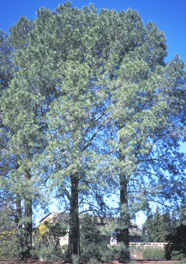
Torrey Pines at Davis, CA photo by ALJ
|
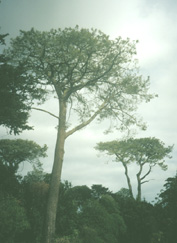
Torrey Pines at Strybing Arboretum, CA photo by ALJ
|
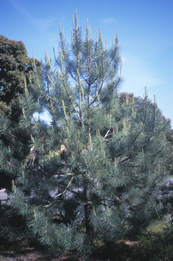
young Torrey Pine at Quail Botanic Garden, CA photo by ALJ
|
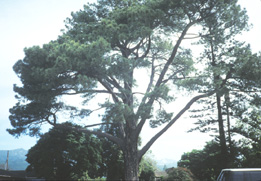
Torrey Pine at Carpinteria, CA photo by ALJ
|
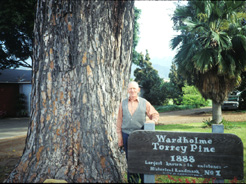
Torrey Pine at Carpinteria, CA photo by ALJ
|
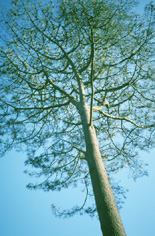
Torrey Pine at Strybing Arboretum, CA photo by ALJ
|

